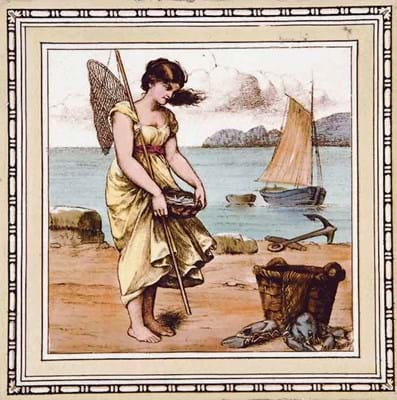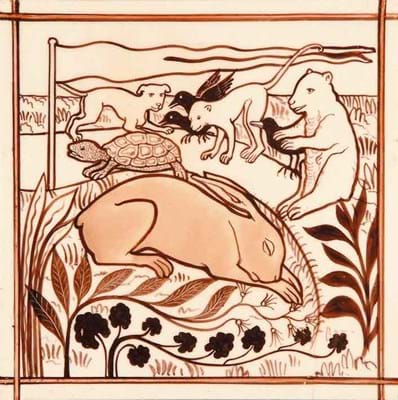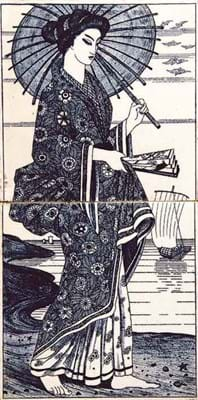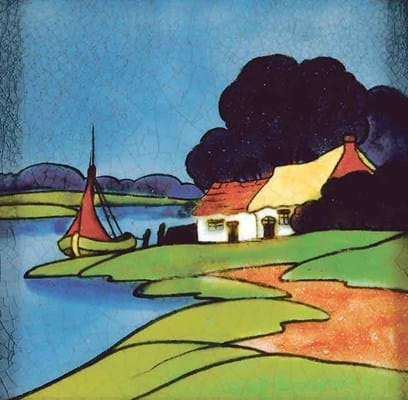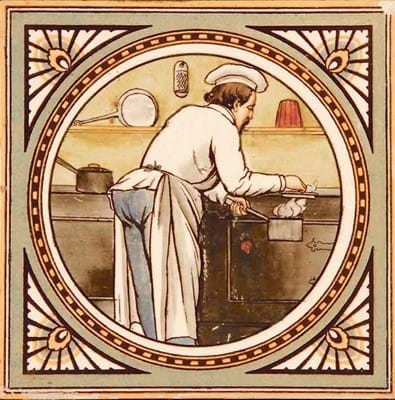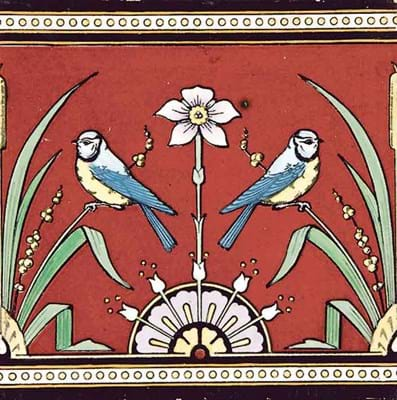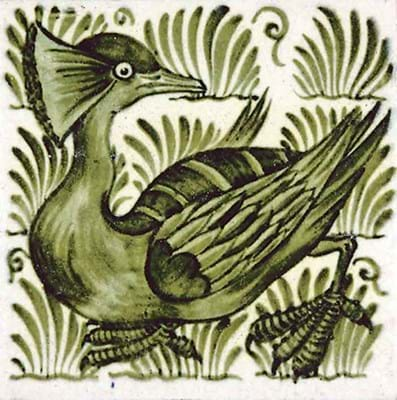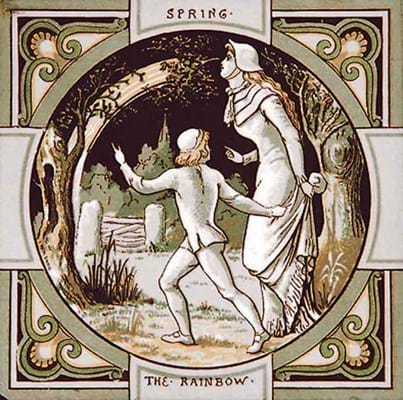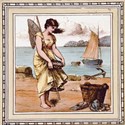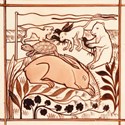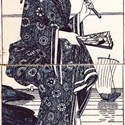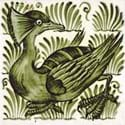Driven by a desire to save her local architectural heritage at a time when so many old houses in the city were lost to redevelopment, she began by encouraging demolition men to save her cast iron fireplaces. Later, as her passion for the subject grew, she would catch the coach to London where she would visit specialist dealers for a day on the tiles.
When family members began to clear the contents of her Arts and Crafts home they found, on the third floor, banana box upon banana box of largely Victorian and Edwardian tiles, some of the rarest lovingly preserved within an almost equally impressive collection of over 500 pairs of trousers and a similar number of woollen sweaters. Imagine the look on the face of her granddaughter's schoolteacher when presented with more than 300 pairs of shoes for a Blue Peter appeal.
Will Farmer, director of Fieldings, was offered a task of greater magnitude late last year when, with typical enthusiasm, he emerged from Hughes' home and declared to her family: "I have had the most wonderful morning of my life".
There were, alongside a collection of some 2000-3000 garden tools and a tail-lift van full of clothes, close to 3500 tiles arranged according to a somewhat byzantine filing system.
Rather than keeping sets together Hughes sorted her tiles into subject matter: frogs in the frog box, farmyard animals in another and so on. A box themed 'flowers', for example, could throw up a William De Morgan alongside a run of pedestrian T&R Boote transfer prints.
This is the sort of sale, in a field where the average unit value is relatively low that, increasingly we must look to the provinces or the internet to find. While we are not yet at the stage where London salerooms are turning away De Morgan beast tiles, there is no doubt that the best would have been creamed off for a decorative arts catalogue before selling the rest on referral or in massive single lots of the type collectors perennially dislike.
Sale Marketing
Not constrained by bean counters demanding minimum lot values, Will Farmer took a stand at a specialist tile fair to display some of the highlights and ask members of the Tiles and Architectural Ceramics Society (TACS) how they would like to see such a large collection dispersed. Unlike Sheila Hughes they wanted to see tiles sold by factory and in as few multiples as possible.
Among 212 registered bidders and 140 successful buyers at the sale on January 12 it was often those collectors who came away with the 'trophy' lots.
Predictably many of the major sums were paid for the 16 tiles by De Morgan.
In the wake of the Creffield collection sold in two parts by Bonhams last year this market has become a little saturated but with realistic estimates designed to avoid the casualties seen in London these held up well.
Most highly rated were two 6in (15cm) early Fulham period 'beast' tiles painted in deep blue to a turquoise ground. A stylised peacock in walking pose took £1550 and a tortoise £1600 (estimates £600-800).
But perhaps a more interesting feature of this sale was the competition for rare Victorian and Edwardian dust pressed transfer printed tiles. There were tiles here that many dealers and collectors had not seen outside reference works.
Sold at £620 (estimate £120-150) was a 8in (20cm) tile by Mintons sepia line printed and painted with a scene of a young fisher girl with a catch of lobster. It carried the signature of William Wise the prolific graphic designer who worked freelance for Minton China Works during the 1870s and 1880s. He specialised in these depictions of rural life - most of which are worth around £40-50 - but this larger tile with coloured decoration is evidently a rarity.
Six (of the 12) tiles from the Mintons China Works' Gastronomic series depicting Victorian characters preparing and digesting food were valued at around £100 a tile. Like the best Minton tiles they were also line printed and then hand enamelled.
They sold at £1550.
Mr Farmer described the cataloguing of this sale as "one of the steepest learning curves of my career."While aided greatly by a copy of Chris Blanchett's 20th Century Decorative British Tiles and TACS members happy to share their knowledge, he was still learning much during and after the sale.
He had tried and failed before the sale to identify the designer of four Minton, Hollins & Co dust pressed tiles each hand enamelled in sepia and black over white glazed ground with scenes from Aesop's fables.
They were estimated at £120- 150 but sold at £800.The reason? They were among a small number of designs done for Minton Hollins by Clement Heaton who is best known for his Arts and Crafts work in stained glass and enamelling.
Equally contested were both a pair of two tile panels by Maw & Co line transfer printed in blue with geishas in kimonos (estimated at £100-150 each) and a pair of early 20th century Pilkingtons tiles hand decorated with cottages to a lakeside setting in majolica style glaze colours (estimate £80-120).
The Japanese ladies are the two sides of a fireplace triptych - the horizontal panel depicts a geisha lying on a bed - and two buyers had to have them. One panel raised £840.The other sold at £800.
Helped by the presence of two collectors, Pilkingtons tiles were a particularly strong section. This pair set in dark stained oak frames took £780.
Outstanding for their sheer quality were two 8in (20cm) Steel & Wood dust pressed tiles that had been hand painted with profile portraits of young ladies emblematic of summer and autumn. One bears the full signature for the freelance decorator Lucien Besche, the second signed in monogram. They took £1120 (estimate £600-800).
Most of the interest in this sale was from the UK but there was a strong American presence and bidders from Europe who often focused upon specific areas: Dutch for the small volume of delft tiles, Germans for Art Nouveau and French for Continental productions.
Tiles designed by Christopher Dresser naturally attract crossover buyers. Another of the much-coveted 'singles' was an 8in (20cm) Mintons China Works dust pressed tile printed and enamelled with bluetits resting on stylised grasses.
This design (listed as pattern book number 1143) comes in two colours: with a terracotta ground and pink flowers, as seen here; and with a white ground and red flowers as seen to two examples in the Harry Lyons Collection sold at Christie's South Kensington in October 2004. The pair (with minor damage) at Christie's made £700.
The single terracotta example here, with small imperfections, took £540 (estimate £80-120).
A Minton, Hollins & Co 6in (15cm) tile hand decorated with a stylised stork feeding its young in a nest in imitation of stained glass was also a Dresser design.
Estimated at £80-120 it took £760.
Not so popular were the J.&W.Wade & Co relief moulded tiles and productions by some of the lesser factories such as T.R. Boote or Packard & Ord.
But these did not remain unsold for long. Shortly after the sale the auctioneers were approached by a client interested in the 16 per cent of the collection that had not sold. A deal was struck with the vendors to bring the selling rate to 100 per cent.
The buyer's premium was 15%.

